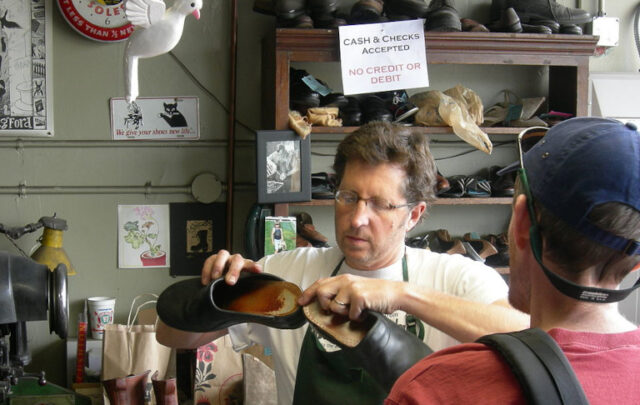Most people have been brought up to believe that the competitive, grow-or-die, absentee-shareholder-owned, “free”-trade “market” economy is the only one that works, the only alternative to a socialist, government-run economy. This myth is perpetrated in business and other schools, by the media, by accountants and lawyers and bankers and, of course, in the business world. This amoral-capitalist economic model has “succeeded” in the same hostile way our species has “succeeded” — by brutally suppressing, starving for resources, using power to steal from, and, when all else fails, killing off anything deemed a “competitor” or threat to its monopoly on power and resources. It relies on massive subsidies and near-zero interest rates thanks to well-rewarded political cronies, on political graft and corruption worldwide, on oligopoly and restraint of competition, on wage slavery and worker ignorance, on phony money and unrepayable debt, and on advertising, human insecurity, ego and greed to create an artificial demand for its shoddy, overpriced crap. And, on top of all that, it’s utterly unsustainable.
For an alternative, natural economy to work, we either have to wait for this amoral-capitalist economy to collapse (which it will, but probably not for a few decades), or we have to plant the seeds for this alternative economy in the cracks where the current one is already failing most badly — at the community level where the economy is most obviously failing to produce meaningful work, sucking resources, wealth and opportunity out, and dumping mass-produced and imported crap that ends up in the landfill, and pollutants in our air, water, soil and food that make us sick and contribute to climate change. But before we can plant these seeds we need to unlearn the nonsense we’re taught and told about economics, and learn how a healthy economy actually works.
Perhaps the best way to explain this is by showing models that contrast the features of the amoral-capitalist economy with those of a cooperative natural economy. Let’s start by looking at two enterprises, a traditional amoral-capitalist one and a cooperative natural one:

The diagram above is a slightly cynical but not unfair depiction of how most entrepreneurs taught amoral capitalist economics start and run their businesses (and I advised hundreds of them, so I’m not making this up):
- It all starts, sadly, with the entrepreneur’s dream that s/he has a better idea, something that the “market” will love as much as s/he does. It’s likely to be something that competes with products or services already offered by established companies, but somehow “differentiated” from them. It’s also likely to be a one-person enterprise to start, and a one-boss enterprise thereafter. Businesspeople who try to do it all themselves are almost sure to overstress themselves, make fatal mistakes, hate most of what they do, and fail, often early and spectacularly.
- Advised by “professionals” who went to the same business schools, the entrepreneur sets up the company as a for-profit corporation, borrows heavily (and expensively) for “start-up” costs, and then hunts for sources for materials and labour to make his/her products and services. It’s quite possible that investors, seeing this as a high-risk investment, will want a large return (high interest rate) and equity position (controlling interest, especially if profit and growth targets are not met) in return for that risk. Once production is started, the company needs to fund customer receivables, inventories, capital equipment, and lots of start-up expenses. Its balance sheet is scary, with no resilience if there are sudden changes in the economy or market, and with a ton of money tied up and no room for error.
- Now our poor entrepreneur has to go head-to-head with established competitors to try to attract customers. S/he will often spend an enormous amount on marketing and advertising to do so. The debts pile up, and little has been sold yet. Our entrepreneur is not sleeping well.
- The idea will now either pay off, or not. Chances are, with incumbents willing and able to take discounts to fend off new competitors, our entrepreneur will not make profit and growth targets. The business might be shut down and liquidated by unhappy lenders and investors, or taken over and the entrepreneur ousted. Or, more simply, it will just run out of cash, and/or make a few naive, fatal decisions.
- But just maybe it beats the odds and succeeds. Now it has to meet grueling annual growth and profitability targets to meet the investors’ demand for a very high rate of return on their investment, to compensate for the heavy risk they took.
- And if it grows it will start to attract the attention of large corporate competitors, which can use their money and position for dozens of usually-effective tactics to crush this upstart. And if it still succeeds, they will shrug, sigh, and make the entrepreneur an offer s/he can’t refuse. The exhausted entrepreneur will usually take the money and run. And either retire, or start all over again (probably not as successfully) with another idea.
This unhappy process explains why most traditional enterprises fail, and why the biggest companies in most industries form collusive oligopolies that control the market, the politicians, and the media, and become “too big to fail” (so if they do screw up, the government — the taxpayer — bails them out).
It has evolved this way for simple Darwinian reasons. It’s what works when the “market” is given some simple (amoral, dysfunctional) rules to operate and is then left to its own resources. It’s a Frankenstein monster, but it was inevitable.
Now let’s look at how a community-based, cooperative economy could work, if it were made up of natural enterprises that “flew under the radar” of the corporate giants, and used a completely different set of processes and rules to get established and operate:

- Our natural entrepreneurs don’t try to do everything alone, and they don’t decide what their offering is to be until they’ve done their market research and identified something in the local community that is needed, and not being met by established companies. As our economy starts to fall apart, such opportunities might be present in just about any essential sector:
- A food co-op, that grows and distributes local, organic foods using permaculture or other sustainable methods (i.e. not dependent on monoculture, wage slave employees, massive oil-based chemical fertilizers and pesticides, and massive irrigation).
- A co-op on the Mondragon model that makes and repairs high-quality, durable, customized clothing from local, sustainable materials.
- An energy co-op that establishes, augments and manages the collective renewable energy of the community.
- Building and furniture co-ops that construct and refurbish buildings and furniture using local materials and labour.
- A housing co-op that builds and co-manages homes and community common spaces for its members and the community at large.
- A local water and water resources stewardship co-op.
- Information, media and technology co-ops that collect, store and disseminate information to the community.
- Theatre, art and recreational co-ops that help the community realize that entertaining yourself is more enjoyable, engaging and fulfilling than consuming packaged entertainment produced elsewhere.
- You get the idea.
- Now, in a process called Peer Production, the local people interested in becoming suppliers, customers or investors of the offering that will fill the unmet need from step 1 above, self-organize and become partners in the enterprise, and co-design the offering to meet their specific needs. This is not rocket science; the reason it isn’t done in traditional economy companies is that it doesn’t scale well up to the multi-national level that traditional enterprises need to grow to to continue to exist.
- The partners now decide which of them will work how many hours in the enterprise and what they will be paid (dependent on their time availability, personal income needs, and the needs of the enterprise — but with little differential between highest and lowest hourly rate, and with an appreciation that the enterprise is not for-profit and must manage its costs prudently).
- They will also decide how much short-term working capital they need (likely to be much less than a traditional enterprise requires, for reasons that will become apparent in a moment), how much the existing partners are willing to invest, and how much they’ll need to obtain from the local Credit Union (which is another local community-based co-op), and what rate of return on investment they will offer (since the product is being made by its potential customers to meet an unfilled need, the risk is low, and so is the needed rate of return). Based on these calculations, they will be able to set a zero-profit price for their offering, and confirm with potential customers that this is viable before even thinking about production.
- Now the partners can pre-order, and prepay the cost of, the offering that they have co-designed to meet their requirements. Additional customers may be brought in at this stage on the same basis. There are no receivables and no unpaid inventory to have to worry about, or to finance. And the Credit Union which is a partner in the co-op will actually buy the equipment and then lease it to the co-op, knowing that the risk of the enterprise failing is low (and hence the lease payments will carry a low risk premium) — so there is no equipment on the balance sheet either, and no need for capital financing. The enterprise begins its life almost entirely debt-free, and stays that way. And the equity is the partners’ — the workers’ — not that of some absentee outside group demanding huge returns, growth and profitability.
- Finally, the offering is produced to the customers who have already bought and paid for it. No expenditure is needed for advertising or marketing, and there is no need for the enterprise to grow, or to earn a profit (just enough to cover its costs). The balance sheet is small and lean, giving the enterprise resilience to deal with changes in the economy and market. Because it’s local, it creates local employment, respects local customs, is better for the environment, and minimizes transportation and other distribution costs. Everybody wins.
As co-operatives of many different types have found, the hard part in doing all this is the re-learning of what collaborative enterprise is all about. It takes a lot of practice, but it’s a natural human endeavour. There are excellent facilitators who can help with enterprise formation, the basics of peer production, invitation (of people in the community to identify and explore unmet needs), consensus, and conflict resolution. Most lawyers, accountants, bankers and traditional consultants should be used as little as possible, since they tend to perpetrate the traditional economy myths and lack the information and experience to know what’s needed in cooperative, natural enterprises. In time a new school of professionals practiced in the natural economy will emerge — I’ve heard that Credit Unions in Germany, for example, now offer “turnkey” financing packages for local wind and solar energy co-ops, complete with training.
As we relearn how to make a living for ourselves, we will be able to help each other out, and establish networks and alliances to share skills, knowledge and resources. I can imagine the growth of a Gift Economy (or what I call a Generosity Economy) blossoming in the abundance of appreciation, know-how, saved time and strengthened relationships that a cooperative natural economy engenders. With time, a community might be able to wean itself off dependence on the amoral-capitalist economy entirely, so that when that economy collapses it will already have made the transition to a steady-state natural economy, and be in a position to help other, unprepared communities with the terrible struggles they will then face.
It’s entirely possible, if we have the will to do it. I see it starting to happen already in some progressive communities that have Transition Initiatives underway. But I have a sense that it will take a few more economic, energy and ecological seismic shocks before many will wake up to the need to find a better way to live and make a living. I’m not sure it won’t be too late by then, but, if we’re in time, we’ll have some models and communities to show us the way.





